We’re one week out from the NHL Trade Deadline and the excitement and speculation continue. Anaheim Ducks general manager and coach, Bob Murray has already been active with the fringes of his roster and considering the team’s position in the standings, people are expecting much more.
But Murray is in new territory. He’s staring a partial rebuild in the face, at least, and the core of his contending teams has expired. This season has already been an active one for Murray but the deadline is still a question mark. Let’s look at some of the busier trade deadlines of Murray’s career to glean what he might do at this one.
Murray’s Trade Reputation
In December, The Athletic’s Craig Custance analyzed the most active NHL GMs (in a five-year span) and when they executed their trades. Murray ranked fifth among them with an average of .67 trades per month. However, he is not among the top 10 GMs in the volume of deadline trades, as he’s traditionally been busier before January, (from ‘Revealing GM tendencies: Which NHL GMs trade the most? When do they like to deal’ – The Athletic NHL – 12/17/18).
This year is different. Murray has already made eight trades; three have been for minor leaguers and five, at least partially, involved NHL players. Five of the eight trades have come after December which, according to Custance, is unusual for Murray. It’s now obvious that the offensive core of Ryan Getzlaf, Corey Perry and Ryan Kesler just isn’t going to cut it anymore. Injury problems aside, the team still struggles to play at the increasing speed the NHL requires.
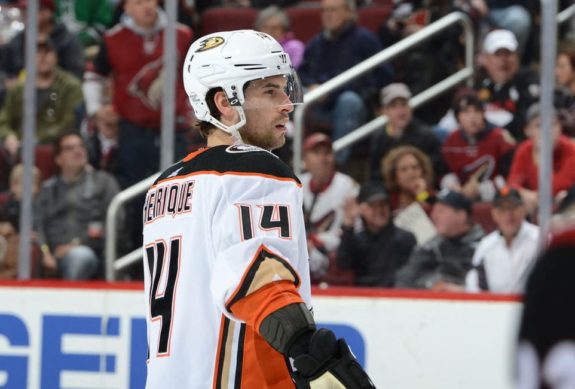
What does this all mean? Even if it isn’t time for a full rebuild, Murray should sell, and it sounds like he’s already trying. The Ducks and San Jose Sharks are reportedly working on a trade for Ryan Miller and Adam Henrique’s name has popped up in speculation as well.
However, Custance’s co-worker at the Athletic, Eric Stephens, thinks Murray will wait until the summer:
“Outside of a smaller move to free up more cap space, the Ducks may stay quiet over the next few days – and then brace themselves for what could be a noisy summer,” (from ‘Ducks trade deadline primer: Smaller moves now, bigger moves in the summer’ – The Athletic – 2/22/19).
Can Murray’s busiest trade deadlines during his career show us anything about what he might do this season?
2009: Ducks Looking for a Pick Me Up
The Ducks’ 2009 trade deadline was a sad one. The team moved on from four important players from their 2006-07 Stanley Cup victory.
The team was in a dogfight for the final playoff spot with four other teams in the Western Conference. Less than two full seasons removed from their title, the team still had a young core and a roster full of players with Stanley Cup experience. To shake up the team, Murray added younger players with less experience and achieved partially successful results. The Ducks made the playoffs but fell to the Detroit Red Wings in the Western Conference Semi-Finals.
In his first deadline as GM, Murray traded with five teams, involving 15 players and one draft pick. He shipped Travis Moen, Samuel Pahlsson, Chris Kunitz and Kent Huskins out of town, all members the Ducks’ Stanley Cup-winning team. Steve Montador and Eric Tangradi were also traded.
In return, the Ducks acquired a young James Wisniewski, who had 13 points in 31 games for the Chicago Blackhawks before the trade and went on to add 11 points in 17 games in Anaheim.
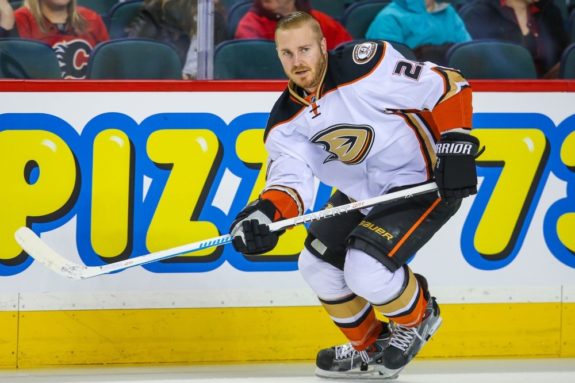
They also received bottom-six forward Petteri Nokelainen who scored six points in 17 games for Anaheim after the trade and young center Erik Christensen who scored nine points in 17 games with the Ducks.
Goodbye Kunitz, Hello Whitney
The strongest addition for the Ducks at the 2009 deadline was puck-moving defenseman Ryan Whitney who came in return for Kunitz and Tangradi who went to the Pittsburgh Penguins. The trade for Whitney was meant to help the Ducks reinforce their blue line with a puck-moving presence. In addition, Murray sought to prepare the team for the eventual loss of either Chris Pronger, Scott Niedermayer or both.
Whitney did contribute from the blue line at a half-point per game pace for the remainder of the season. He also added six points in 13 games in the playoffs.
For Huskins and Moen, the Ducks also received Nick Bonino. Bonino played parts of five seasons in Anaheim topping out at 49 points the season before Murray traded him. The way he left Anaheim is significant as he was part of the package deal that landed the Ducks Kesler in their June 27, 2014, trade with the Vancouver Canucks. That may not have been a positive move, considering Kesler’s current production and the time he has left on his contract.
This trade deadline demonstrated from the get-go that Murray would not hesitate to trade established veterans, even if they played a crucial role in winning a Stanley Cup. If Murray was willing to trade players like Kuntiz, Moen and Pahlsson, it shouldn’t have been surprising that he was willing to trade Andrew Cogliano earlier this season. It also showed that those jarring moves could help push a team into a playoff spot like it did in 2009.
2010: Murray’s Busiest Deadline
The 2010 NHL Trade Deadline, which fell March 3, was Murray’s busiest trade deadline of his career as Anaheim’s GM. On that deadline and the week leading up to it, Murray made eight trades with eight different teams involving 12 players, five draft picks and future considerations.
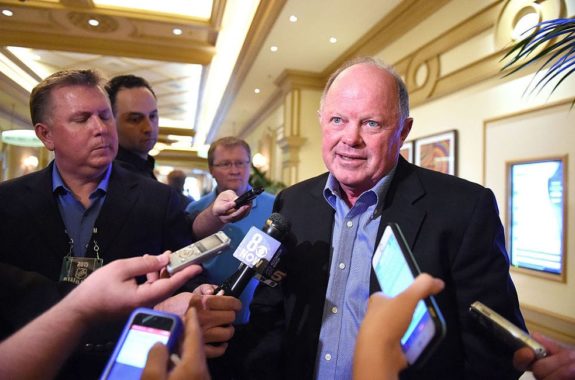
In March 2010, the Ducks were No. 12 in the Western Conference standings but only four points out of the playoffs. Still, they had to pass four teams to jump into the final slot. Similarly, this season, the Ducks are on the periphery of the playoff hunt, but in a conference where no other bubble team wants to take control of the race.
When it comes to the roster, things are far different now. Back then, Perry and Getzlaf were in their prime, and Bobby Ryan was in the midst of scoring his career high in goals. Saku Koivu was still productive and let’s not forget Teemu Selanne. Niedermayer — in the final season of his career — still led the defense with 48 points. Wisniewski and Whitney also manned the blue line.
That team had far more potential than the 2018-19 Ducks.
Hello Backup Goalies, Goodbye Whitney
In 2010, Murray tinkered with the fringes of his roster again. He acquired Nathan Oystrick from the Atlanta Thrashers for Evgeny Artyukhin. He received a 2011 seventh-round pick for goaltender Joey MacDonald, and he traded goaltender Justin Pogge and a pick for defenseman Aaron Ward from the Carolina Hurricanes. He also sent goalie Vesa Toskala to the Calgary Flames for another goalie, Curtis McElhinney.
Why all of the goaltenders? Murray had traded Jean-Sebastien Giguere in January of that season to free up cap space and because Jonas Hiller had taken over the starting role. As a result, the Ducks were looking for a steady backup goaltender.
There was one exception to Murray’s fringe trades. He sent Whitney and a sixth-round pick to the Edmonton Oilers for Lubomir Visnovsky. The Czech defender scored 13 points through 16 games with Anaheim that season, but the team failed to make playoffs.
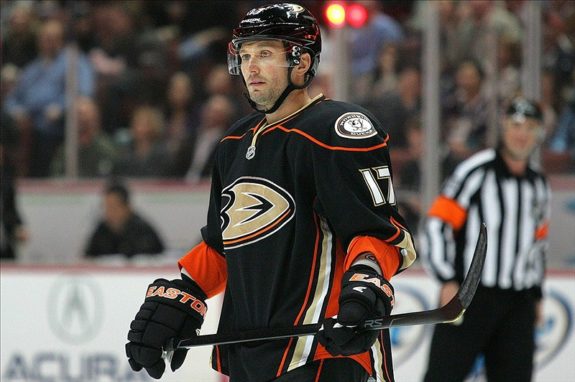
Visnovsky became a valuable asset for the Ducks in the following two seasons. He lead the defense in scoring in 2010-11 and came in second in defensive scoring to rookie Cam Fowler in 2011-12.
What can we take from all of this? Much like January of this season, when the Ducks were mid-freefall, Murray thought his team could still compete for a playoff spot. He made lots of smaller moves to shake up the roster, but he waited to see if his core could fix the issue. The “fringe move” phase of the season has already happened, which supports Stephens’ assertion that Murray could already be done with most of his trading.
2015: Ducks Don’t Fix It If It Ain’t Broken
The 2014-15 season may have been the Ducks’ best chance to win a Stanley Cup with Murray as GM. They were by far the best team in the Pacific Division, and they had a healthy Kesler and an emerging Sami Vatanen.
At the time of the March 2 trade deadline, the Ducks sat first in the Pacific by 12 points. The playoffs were virtually assured, but that’s not to say the Ducks didn’t have needs. With the late-season injury to Vatanen and other Western Conference contenders adding defensive depth, the Ducks were also in the market for a defenseman. Rumors swirled around names like Zbynek Michalek and Keith Yandle.
In the end, Murray made six trades with six teams in the week leading up to the deadline, including 13 players and four draft picks. The players going both ways played more significant roles than in 2010 but didn’t reach the “big splash” status as if they had acquired Yandle.
The team traded for depth forwards Jiri Sekac and Tomas Fleischmann from the Montreal Canadiens and Florida Panthers respectively. In return, they traded Devante Smith-Pelly to Montreal and Dany Heatley and a third-round pick to Florida.
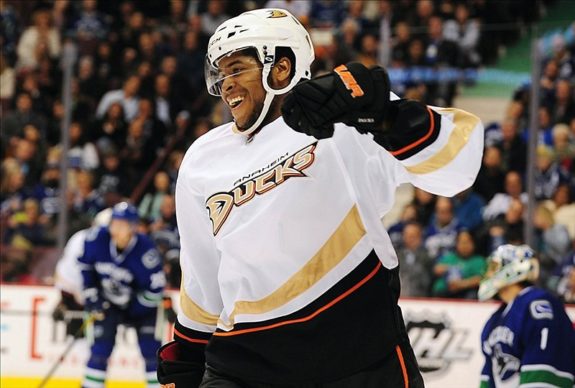
They addressed their defensive depth by reacquiring Wisniewski from the Columbus Blue Jackets in return for Rene Bourque, William Karlsson and a second-round pick. They also traded steady defenseman and penalty killer Ben Lovejoy back to the Penguins for more offensively minded defender Simon Despres. Finally, they added German defender Korbinian Holzer from the Toronto Maple Leafs for Eric Brewer and a fifth-round pick. Holzer did not play a game for the Ducks that season.
The Ducks also sent Mat Clark to the Colorado Avalanche for forward Michael Sgarbossa, who didn’t play a game for the Ducks that season either.
Hindsight is 2015 for the Ducks
None of the moves Murray made had a huge impact on the team’s production. Of the players Murray traded for, Despres had the best playoff impact contributing one goal and seven assists during the team’s march to the Western Conference Final.
It’s hard to blame Murray for not doing enough. With a team that had had such a good track record in the regular season, why make a major change to the roster if he could add depth both at forward and defense for what didn’t seem like a lot at the time?
With the benefit of hindsight, however, Murray may have even gone too far. While the Washington Capitals just waived Smith-Pelley and he’s been a bottom-six forward throughout his career, he did score seven goals and eight points on the way to a Stanley Cup with the Capitals.
The more significant loss was obviously Karlsson. Now that we know how things turned out, giving up Karlsson was an overpayment for Wisniewski, who didn’t play a single game in the Ducks’ 2014-15 playoff run.
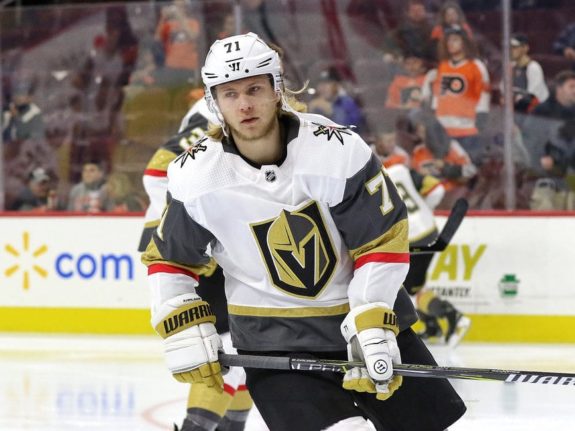
Karlsson’s emergence with the Las Vegas Golden Knights last season may have been an anomaly, but his offensive ability has still produced 18 goals and 20 assists so far this season. The Ducks could undoubtedly use Karlsson’s speed and offense now.
Even so, Murray was not the only GM to pass on Karlsson. Columbus GM Jarmo Kekalainen left Karlsson exposed in the 2017 Entry Draft, which is how he landed in Las Vegas. Not to mention that the Ducks were stacked and Karlsson played much of the season in the AHL or in a bottom-six role. His breakout season had a lot to do with his first-line role with the Golden Knights, and that was not an option at the time in Anaheim, so you can’t blame Murray for trading Karlsson at the 2015 deadline.
It’s obvious that this season, the Ducks are in the opposite situation they were in 2014-15. The likelihood that they jettison a promising young prospect or even one with a cloudier future is low. If Murray does trade a top prospect, it better be for a pretty darn good return.
Lessons to Learn
So, what does this all mean for this season’s approaching trade deadline? Above all else, it should tell you that the Ducks and Murray are in new territory (thank you captain obvious). Yes, they’ve been within striking range of a playoff spot this late in the season before. Sometimes they’ve made it, sometimes they haven’t, but the critical difference is the state of the team.
Anaheim’s core has expired. They are no longer an underachieving, yet promising young team; they are old and fading. But could their recent success motivate Murray to keep valuable players? Reports have surfaced that he and Jakob Silfverberg’s camp have agreed to a new contract.
Ducks hint at future by keeping, not trading, Silfverberg https://t.co/nOy829HzTp
— NBC Sports Hockey (@NBCSportsHockey) February 21, 2019
Silfverberg’s name was perhaps the most frequently mentioned in trade rumors. Could Murray be willing to keep other players who could net a big return in a last-ditch attempt to grab the last playoff spot?
As Murray has shown, when he thinks his team is underachieving, he isn’t afraid to make a lot of changes to try to shake things up. This season, however, those moves seemingly have already been made with little effect. If Murray does decide to sell a major piece to accumulate draft picks, as Stephens has pointed out, he may wait until after the season. That doesn’t mean fans can’t look at the deadline with eager anticipation anyway.
All stats and trade info from hockey-reference.com and nhltradetracker.com